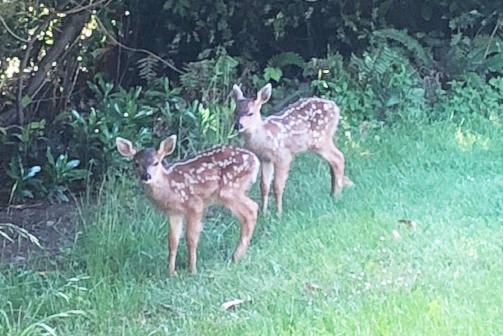If you’ve driven or cycled the local neighbourhood, you’ve likely happened upon does grazing or waiting for an opportunity to cross the road.
And as spring brings fawning season, it serves as a timely reminder to slow down, scan ahead, and be mindful that just like young children, wildlife can act unpredictably when presented with an unknown or unexpected situation.
“We always urge drivers and cyclists to slow down and be mindful, especially in areas deer are known to frequent, but this time of year, when does are beginning to move with their young fawns, it’s time to pay a little extra attention as you drive, cycle and stroll your neighbourhoods,” says David Budd, Vice-President of the Urban Wildlife Stewardship Society.
The society is working with the Township of Esquimalt on deer management, in addition to undertaking a research and deer contraception program in Oak Bay.
Alone, not abandoned – If you find a fawn that looks like it’s alone, don’t assume it’s been abandoned.Fawns are born without scent, and for the first few weeks, does may feed and sleep a considerable distance from the fawn or leave for long periods to forage, before returning to let fawns to suckle. Both behaviours help reduce the chance of attracting predators.
If you see one deer, more are likely nearby – Once summer arrives, does will also begin introducing fawns to the wider world, and they’ll start following mum out to forage. However, young deer may be tentative as they approach the road and may not recognize vehicles as a threat. Others may dart out, or get confused by headlights. Be cautious, and remember that deer are rarely alone.
Dusk and dawn alert – Deer often appear suddenly, perhaps startled by people, dogs, traffic or even other deer, and tend to be more active at dawn and dusk – the very time it’s more difficult to see them. Reduce your chance of colliding with a deer by slowing down and scanning ahead, especially in areas deer are known to frequent.
Protective parenting – Just like we’ll protect our children from a perceived threat, does will also act in a protective manner if you near a fawn. If a doe seems to follow you, try changing direction or crossing the road, as you may be unknowingly walking toward a hidden fawn.
Keep dogs close – While you keep distance between you and the deer, it’s also important to keep your dog close to you. Does perceive dogs as a threat, so keeping them leashed and walking near you will help prevent unwanted interactions.
For more tips about living with urban deer, visit esquimalt.ca or uwss.ca.
